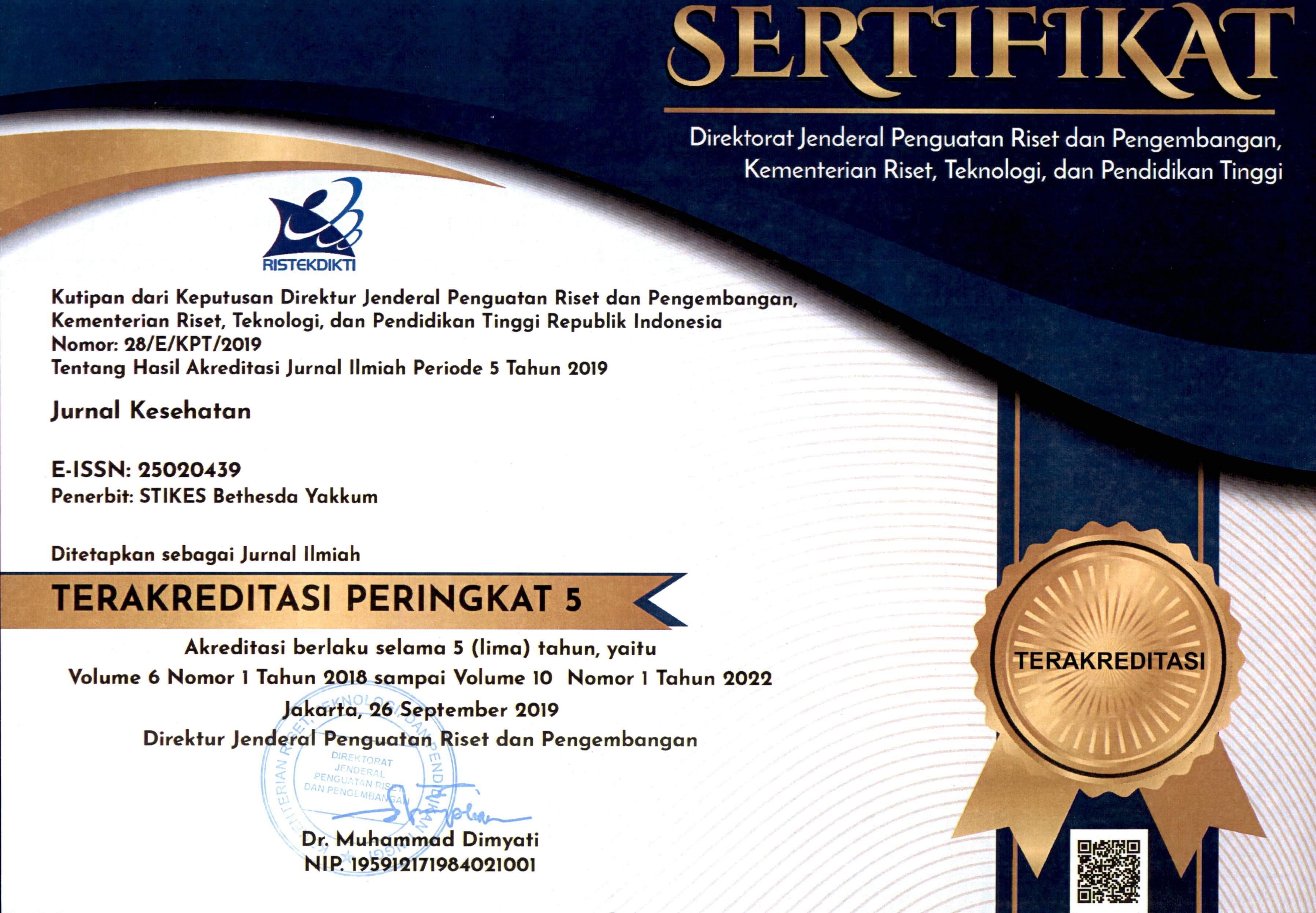ANALISIS FAKTOR-FAKTOR PENCEGAHAN HIV/AIDS PADA MAHASISWA KEPERAWATAN DENGAN PENDEKATAN TEORI HEALTH BELIEF MODEL
DOI:
https://doi.org/10.35913/jk.v8i2.201Keywords:
Keywords: Factors, Behavior, Prevention, HIV / AIDS.Abstract
ABSTRACT
Human Immunodeficiency Virus (HIV) is still a major public health problem in various countries including Indonesia. Students are a group of adolescents of productive age who are at this age vulnerable to HIV / AIDS transmission. Adolescence is the age of the majority of students who are considered vulnerable to infection because of their lack of knowledge about the dangers of HIV / AIDS. The purpose of this study was to determine the factors associated with HIV / AIDS prevention in nursing students. The method in this research is quantitative with a cross sectional approach. The study population was nursing students at Citra Bangsa University and STIKes Maranatha Kupang. The research sample was nursing students who were taken by purposive sampling technique with a sample size of 100 respondents, then analyzed using the Chi Square test. The results showed that perceptions of perceived vulnerability, perceptions of perceived seriousness, perceptions of perceived benefits, perceptions of perceived barriers, perceptions of cues to action, self-efficacy have a significant relationship with HIV / AIDS prevention in Citra Bangsa University and STIKes students. Maranatha Kupang. The results of this study are useful for the students concerned to maintain and improve their behavior to prevent HIV / AIDS and other sexually transmitted diseases.
.
Keywords: Factors, Behavior, Prevention, HIV / AIDS.
References
Alwisol. (2009). Self efficacy anak didik pemasyarakatan di Lapas anak kelas IIA Blitar. Retrieved from Http://Etheses.Uin-Malang.Ac.Id/1236/6/11410061_Bab_2.Pdf., 13–39. http://etheses.uin-malang.ac.id/1236/6/11410061_Bab_2.pdf
Arulita Ika, F. (2013). Keikutsertaan Pelanggan Wanita Pekerja Seks Dalam Voluntary Conseling and Testing (Vct). KESMAS - Jurnal Kesehatan Masyarakat, 8(2), 161–165. https://doi.org/10.15294/kemas.v8i2.2640
Dement, J. M., Epling, C., Østbye, T., Pompeii, L. A., & Hunt, D. L. (2004). Blood and body fluid exposure risks among health care workers: Results from the Duke health and safety surveillance system. American Journal of Industrial Medicine. https://doi.org/10.1002/ajim.20106
Eda, N., Widjanarko, B., Widagdo, L., Promosi, M., Universitas, K., & Semarang, D. (2012). Niat Penggunaan Kondom pada Komunitas Waria di Kota Ternate. Niat Penggunaan Kondom Pada Komunitas Waria Di Kota Ternate, 7(2), 174–183. https://doi.org/10.14710/jpki.7.2.174-183
Kementrian Kesehatan RI. (2018). General situation of HIV/AIDS and HIV test. In Pusat Data dan Informasi Kementrian Kesehatan RI (pp. 1–12). file:///C:/Users/hp/Downloads/InfoDatin-HIV-AIDS-2018.pdf
KPAD, N. (2019). KUMULATIF HIV/AIDS.
Polit, D. F., & Beck, C. T. (2014). Essentials of Nursing Research Seventh Edition Appraising Evidence for Nursing Practice. In Lippincott Williams & Wilkins. https://doi.org/10.1017/CBO9781107415324.004
Pratama, A. Y. (2016). Faktor-Faktor yang Mempengaruhi Perilaku Seksual Wanita Pekerja Seksual Tidak Langsung ( WPSTL ) Dalam Upaya Pencegahan HIV / AIDS ( Studi Kasus di Warung Remang-Remang Luwes Surodadi Gringsing Kabupaten Batang ) SKRIPSI. https://lib.unnes.ac.id/28320/1/6411412046.pdf
Priyoto. (2014). Teori Sikap Dan Perilaku Dalam Kesehatan: Di Lengkapi Contoh Kuesioner. http://103.255.15.77/detail-opac?id=268942
profil kesehatan indonesia. (2018). Provil Kesehatan Indonesia 2018 (Vol. 1227, Issue July). https://doi.org/10.1002/qj
Rosenstock, I. M., Strecher, V. J., & Becker, M. H. (1988). Social Learning Theory and the Health Belief Model. Health Education & Behavior. https://doi.org/10.1177/109019818801500203
Sakinah, Z. V. (2018). Aplikasi Health Belief Model Dalam Menganalisis Perilaku Penggunaan Kacamata Pelindung. Jurnal PROMKES, 5(1), 115. https://doi.org/10.20473/jpk.v5.i1.2017.115-128
Salsabila, M. P. (2019). Gambaran Persepsi Mahasiswa Tentang Penularan Penyakit HIV / AIDS Di Universitas Muhammadiyah Semarang. 277–286. http://prosiding.unimus.ac.id/index.php/mahasiswa/article/viewFile/474/477
UNAIDS. (2019). DATA AIDS. https://www.unaids.org/en
Widayanti, L. P., Hidayati, S., Lusiana, N., & Ratodi, M. (2018). Hubungan pengetahuan tentang HIV/AIDS dan sikap mahasiswa terhadap ODHA. Journal of Health Science and Prevention, 2(2), 100–107. file:///C:/Users/hp/Downloads/129-Article Text-350-2-10-20190129.pdf
Wulandari, Y. A., Suryani, N., & Pamungkasari, E. P. (2016). Health Belief Model: Health Preventive Behavior of Sexually Transmitted Infection in Female Sex Workers in Surakarta. Journal of Health Promotion and Behavior. https://doi.org/10.26911/thejhpb.2016.01.02.02









